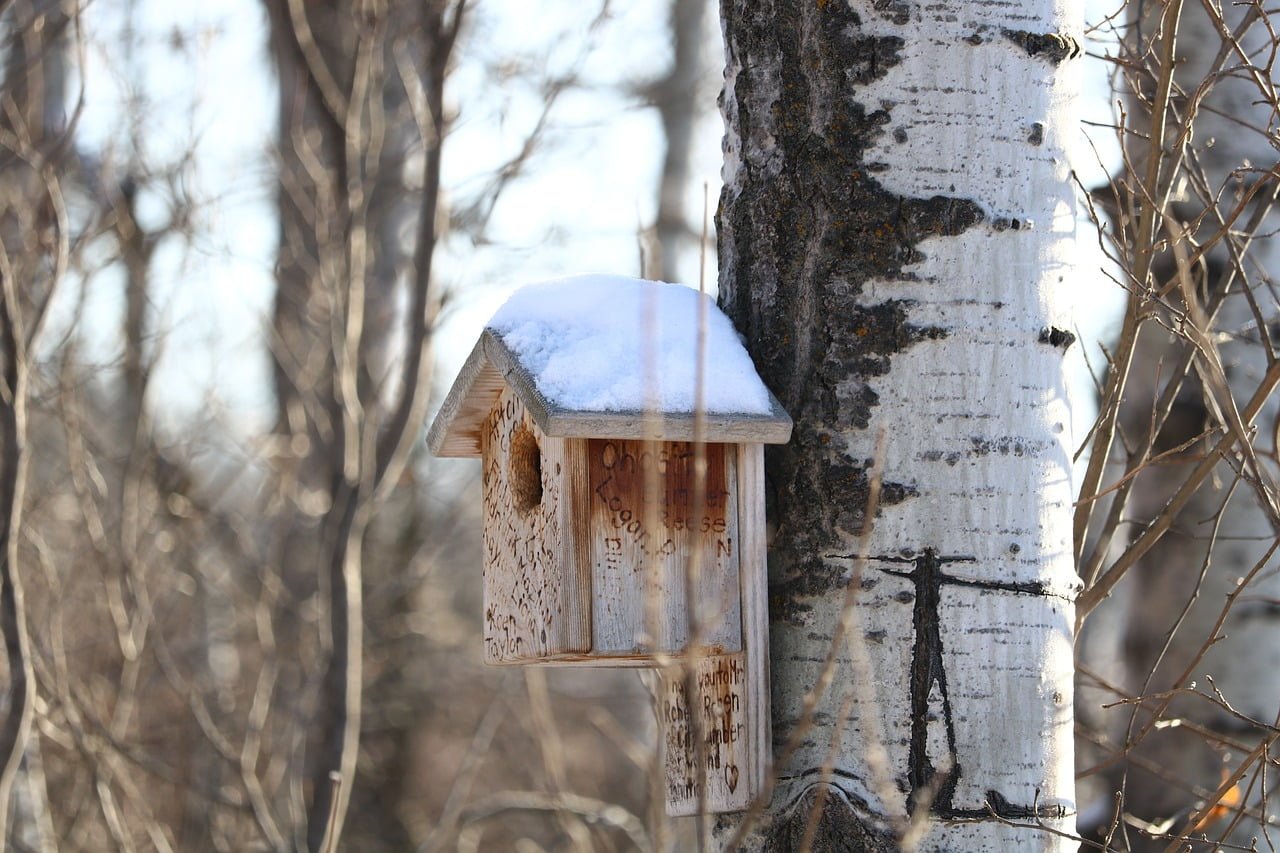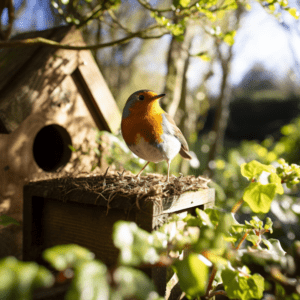Winter can be a harsh time for our garden wildlife. As temperatures drop and food becomes scarce, birds, animals, and insects struggle to survive. By making a few simple changes, you can transform your garden into a vital winter sanctuary that provides much-needed food, water, shelter, and safety.
In this post we will outline some ways you can transform your back garden into a winter wildlife garden to support wildlife through the colder months.
Top Tip
Plant hardy native berry producers like holly, dogwood, and cotoneaster to provide birds with vital winter food sources.
This post contains affiliate links which means we may make commission from any qualifying sales with no extra cost to yourself.
Understanding Wildlife Needs in Winter

To create a thriving winter habitat, it helps to understand what birds, mammals, and insects require during the colder months.
Birds
Many bird species do not migrate for winter. They tough out the cold temperatures and shorter days right alongside us. Food and shelter become scarce, making survival challenging. You can help by:
- Providing high-energy foods like suet, nuts, and seeds.
- Offering fresh water for drinking and bathing.
- Letting faded seed heads stand for foraging.
- Allowing leaf litter to accumulate for shelter.
- Installing roost boxes and keeping some trees and shrubs untrimmed for protection from wind and sleet.
Some birds, like robins and blackbirds, will particularly appreciate winter berries.
Mammals
Garden mammals like hedgehogs, mice, voles, and squirrels stay active in winter. They build up fat reserves in autumn that help insulate them from the cold. But they still need extra provisions to make it through. You can help by:
- Leaving out high protein foods like mealworms, sunflower hearts, and suet.
- Providing fresh water in shallow, non-tipping dishes.
- Piling up leaves, sticks, and mulch for nesting areas.
- Letting tall grass stand for shelter and insulation.
- Making or purchasing small mammal homes for hedgehogs and others to hibernate in.
Insects
Butterflies, bees, and other beneficial insects overwinter as larvae, pupae, or adults hidden away in leaf litter, crevices, and other garden nooks. Avoid raking up all fallen leaves so they remain undisturbed. You can further help by:
- Leaving some plant stems and seed heads for egg laying.
- Building insect hotels from logs, sticks, and leaves for shelter.
- Planting early pollen and nectar sources like winter aconite, crocus, and mahonia.
With a basic understanding of winter needs, you can now choose elements to help your backyard birds, animals, and insects not just survive, but thrive.
Plants for a Winter Wildlife Garden
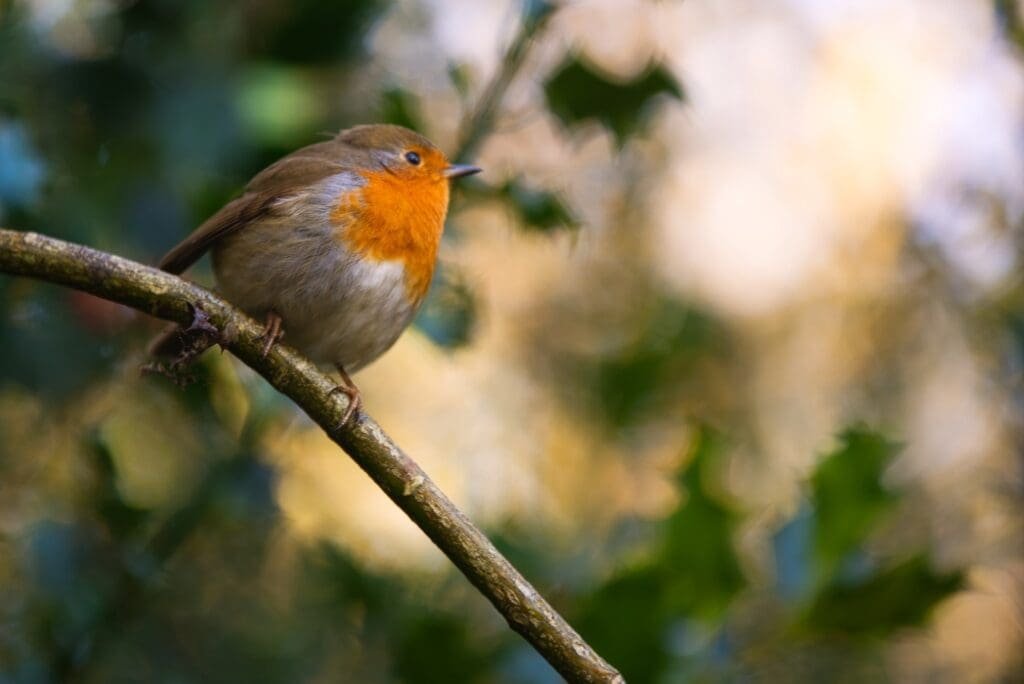
Selecting wildlife-friendly plants can provide vital food and shelter all winter long. Focus on hardy native species, evergreens, and berry producers.
Native Plants
Native plants suit local wildlife best. They coevolved together and cater perfectly to each species’ needs. Examples include:
- Trees: Crabapple, hazel, rowan, alder, birch
- Shrubs: Holly, dogwood, guilder rose, buckthorn, willow
- Perennials: Teasel, knapweed, feverfew, oxeye daisy
These plants provide insects, seeds, nuts, and berries that sustain birds and small mammals. They also furnish better shelter, nesting sites, and protection than non-natives.
Evergreens
Evergreens keep their leaves year-round. This provides crucial shelter from harsh weather when deciduous trees have dropped their foliage. Evergreens also produce cones and seeds. Recommended varieties include:
- Large Trees: Scots pine, Austrian pine, Cedar of Lebanon
- Medium Trees: Holly, yew
- Shrubs: Boxwood, Osmanthus
Choose evergreen species based on your garden size and constraints. Even potted evergreens can make great shelters on balconies and patios.
Berries and Seed Plants
Seeds and fruits left on plants are an indispensable winter food source. Berry plants are particularly important for birds like robins, blackbirds, and waxwings. Excellent choices include:
- Shrubs: Cotoneaster, pyracantha, mountain ash
- Climbers: Honeysuckle, ivy, Virginia creeper
- Perennials/Grasses: Coneflower, liatris, fescues
Select a variety of seed and berry plants to provide a consistent winter diet. Mix in some ornamental grasses too for plump, protein-rich seeds.
Food and Water in your Winter Wildlife Garden
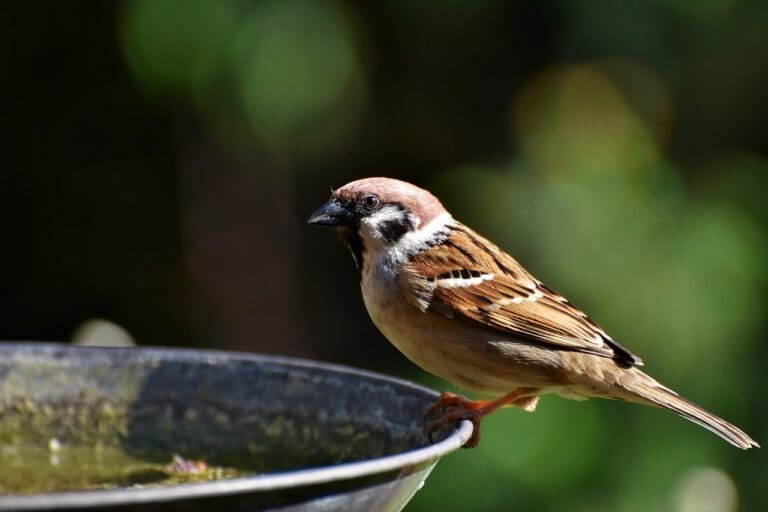
Supplementing what plants supply with additional feeding and water sources is hugely beneficial. Offer a diverse winter menu to support all your wild visitors.
Bird Feeders
Feeders provide essential energy-rich foods when natural supplies run low. Offer suet, insect suet cakes, sunflower hearts, peanuts, millet, nyjer, and mixed seed blends.
Tips:
- Clean feeders regularly to prevent disease.
- Place near trees or shrubs to provide escape cover.
- Use mesh guards to keep out large bullies.
- Raise on poles with baffles to deter squirrels and cats.
- Supplement feeders with fruit skewers, nut wreaths, and fresh water.
Insect Hotels
Insect hotels built from old wood and hollow stems give beneficial insects like ladybugs, lacewings, and solitary bees a cosy spot to overwinter. You can make a basic one by:
- Gathering materials like drilled logs, bamboo canes, bark, and sticks.
- Layering materials loosely into a crate, box, or wire frame.
- Situating the hotel in a sheltered, dry spot facing east or south.
Small Mammal Feeding
Supplement hedgehogs, mice, voles, and squirrels with:
- Mealworms, chopped nuts, and crumbled suet.
- Shallow, non-tip bowls of fresh water.
- Allow fallen fruit to remain under trees.
Safety Tips:
- Place small dishes of food at ground level on flat surfaces.
- Keep away from fences and walls to avoid predator ambush sites.
- Remove uneaten food after a few days to discourage pests.
Access to Liquid Water
Liquid water is vital for drinking, bathing, and preventing dehydration. Prevent ponds and bird baths from freezing with:
- Floating heaters designed for bird baths.
- Footballs or floating ping pong balls to keep a section ice-free.
- Submersible pond heaters.
- Frequent refilling if needed.
Ensure water is not too deep for small birds and mammals. Add ramps or stones so hedgehogs can climb out easily.
Providing Shelter in your Winter Wildlife Garden
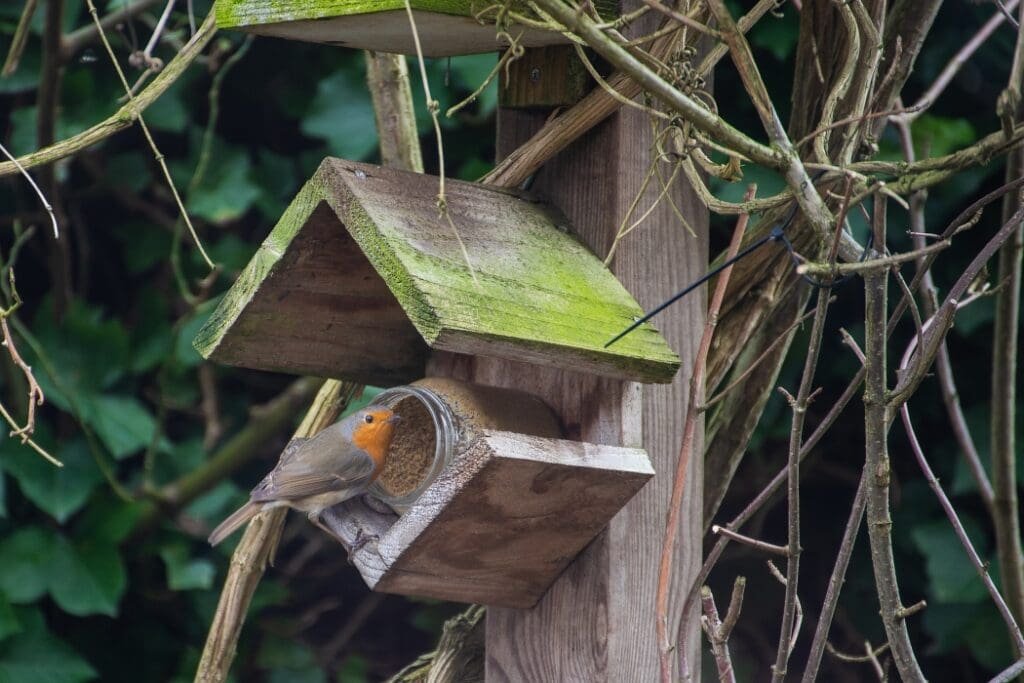
Safe spaces to shelter from harsh conditions are key. Birds, mammals, and insects all need places to hunker down in severe weather.
Hedgehog Homes
Give hedgehogs a helping hand by making cosy winter dens:
1. Use an empty wooden box or plastic tote, or purchase a hedgehog house.
2. Cut a 5-6 inch hole in one side for entry.
3. Line with dry leaves, straw, or newspaper for nesting material.
4. Place in a sheltered spot near leaves and log piles.
5. Provide extra insulation with leaves, straw, etc. if needed.
6. Secure a brick on the roof to prevent blowing away.
Birdhouses and Roosting Pockets
Many birds roost in cavities during winter for warmth and protection. You can provide shelter by:
Installing birdhouses designed specifically for winter roosting. Choose ones with good insulation and ventilation.
Filling mesh onion bags with leaves, then hanging them as instant roosting pockets in trees and shrubs.
Leaving some trees, shrubs, and brush piles untrimmed for natural nesting nooks.
Leaf Mounds
A brush pile or mound of autumn leaves makes a great winter refuge. Leave them available in out-of-the-way corners. To make:
Choose a spot under trees or near shrubs and fences.
Pile up fallen leaves, sticks, and garden debris.
Top with a preserve sheet to keep dry.
Weight it down with logs or bricks.
Leave undisturbed as winter shelter.
Protecting Our Garden Wildlife
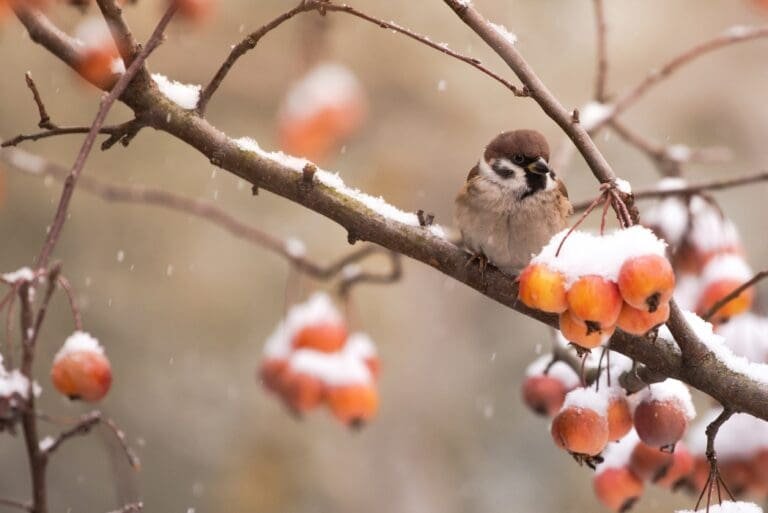
Take a few precautions to ensure your winter garden remains safe and healthy for wildlife.
Avoid Harmful Chemicals
De-icers, salts, herbicides, and pesticides can be toxic. Use sand or kitty litter instead of salt on paths, and opt for natural pest deterrents like soap spray.
Offer Shelter from Extremes
Severe cold, wind, ice, and storms can be deadly. Ensure wildlife has access to insulated shelters and protection.
Don’t Disturb Leaf Litter & Logs
Leave fallen leaves, sticks, and dead wood intact. These provide vital winter habitat. Avoid unnecessary tidying.
Monitor Water Sources
Check ponds and bird baths daily to prevent freezing over. Break up any ice so wildlife has continual access.
Final thoughts
With a bit of planning, you can create a winter sanctuary that provides food, water, shelter, and safety for local wildlife. Don’t let your garden go dormant when wildlife needs it most! Focus on hardy native plants, ample feeding stations, accessible water, and cosy shelters. With these elements in place, you’ll be rewarded with active birds, animals, and insects to enliven your garden all winter long.
So take that first step today. Maybe it’s planting a berry-filled holly shrub, leaving some faded flower heads standing, or installing a roosting box. However you choose to start, know that every small act makes a difference. When we garden with compassion for nature’s needs, we spread a little more joy, beauty, and vitality into the world.
Frequently Asked Questions
Q. How can I help my birds in winter UK?
Provide bird feeders with high-energy foods like suet, nuts, and black oil sunflower seeds. Offer fresh water daily and install heated bird baths. Leave seed heads and berries on plants for foraging. Put up roost boxes and keep shrubs untrimmed for shelter.
Q. How do I get hedgehogs in my garden?
Put out hedgehog food like cat biscuits, mealworms and chopped nuts. Provide a hedgehog house or leaf/log pile for nesting. Create access holes in fences. Avoid using chemicals or slug pellets. Hedgehogs will discover and take up residence in suitable gardens.
Q. What plants is best for a wild garden?
Focus on hardy native plants like hazel, crabapple, hawthorn and holly trees. Dogwood, rosehip and honeysuckle shrubs also work well. Evergreen shrubs give winter shelter. Herbaceous plants like oxeye daisy, foxglove and teasel provide seeds. And include berry producers like ivy, cotoneaster and holly for food.

